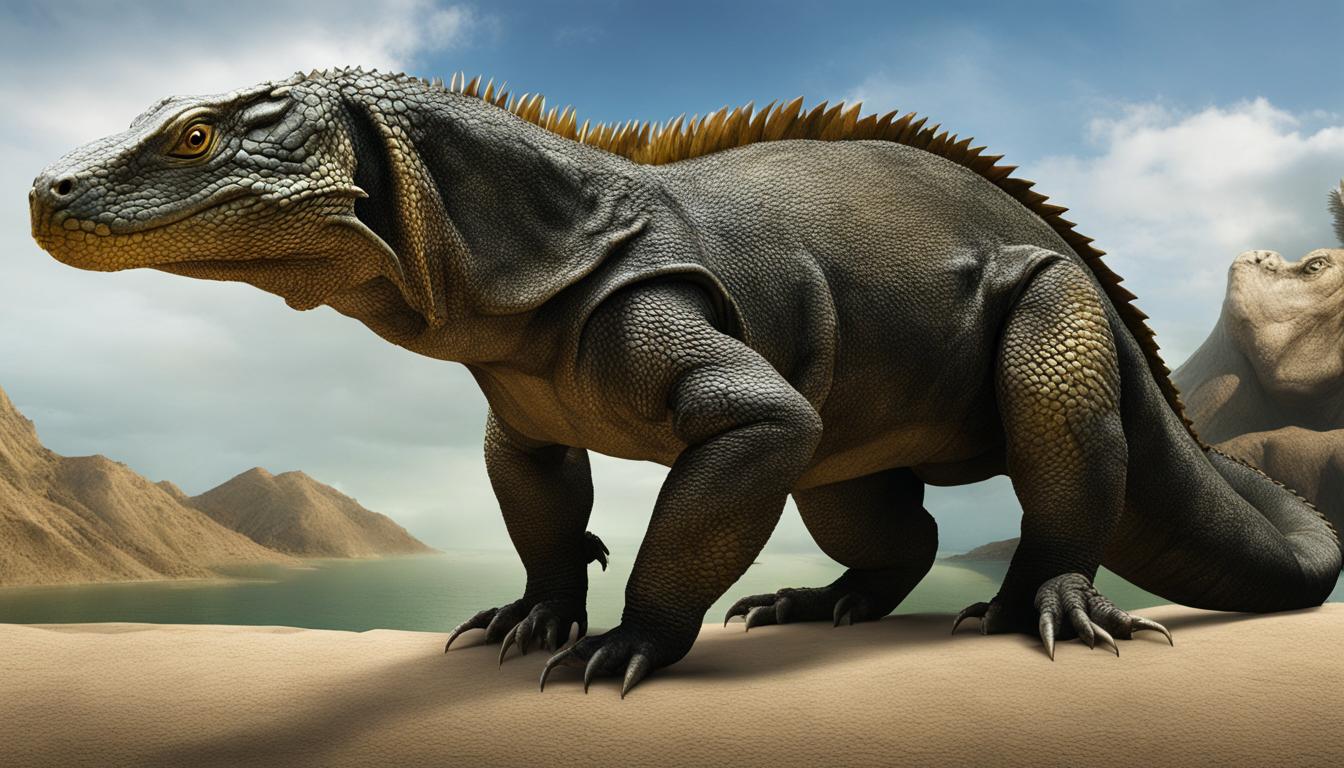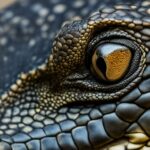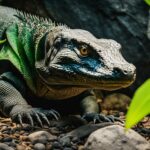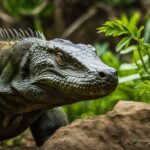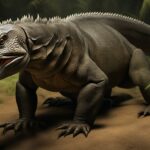Are you ready to dive into the fascinating world of the largest lizards on Earth? In this article, we will explore the incredible size of Komodo dragons, uncovering their impressive dimensions and unique characteristics.
Prepare to be amazed as we delve into the dimensions of these magnificent creatures, from their remarkable weight to their astounding length. Let’s embark on a journey to discover the true giants of the reptile world!
The Impressive Weight of Komodo Dragons
When it comes to size, Komodo dragons are truly remarkable creatures. Not only are they the largest lizards in the world, but their weight is equally astonishing. On average, these formidable reptiles weigh around 70 kgs (154 lbs), which is slightly heavier than the average weight of a human.
However, the weight of Komodo dragons can vary greatly. The largest recorded individual weighed a staggering 166 kgs (366 lbs), surpassing the weight of a standard refrigerator. Such weight is attributed to their ability to expand their stomachs, allowing them to consume up to 80% of their own body weight in a single meal, a feat that few other animals can achieve.
This impressive weight is not only a result of their large size but also their muscular build. Komodo dragons have a powerful tail, strong claws, and a large jaw filled with 60 large serrated teeth measured at 2.5 centimeters (1 inch) in length. Additionally, their bodies are covered in osteoderms, bony plates that provide protection and contribute to their formidable predatory abilities.
The Impressive Weight of Komodo Dragons
| Weight Range | Average Weight | Maximum Weight |
|---|---|---|
| Adult Komodo Dragons | Around 70 kgs (154 lbs) | Up to 166 kgs (366 lbs) |
“Komodo dragons can easily consume up to 80% of their own body weight in a single meal.”
With their impressive weight and muscular build, Komodo dragons are not only a sight to behold but also a force to be reckoned with.
Astounding Length of Komodo Dragons
Komodo dragons, the largest extant lizards in the world, boast an astounding length that sets them apart from other reptiles. Adult male Komodo dragons can reach lengths of 3 meters (10 feet), while females are slightly smaller, with a maximum length of 1.8 meters (6 feet). These measurements make them significantly longer than the average height of a human man. Just imagine coming face to face with these colossal creatures!
From the moment they hatch, baby Komodo dragons measure around 30 centimeters (1 foot) in length. It takes them 5-7 years to grow into their full size, gradually outgrowing their initial size, but always remaining awe-inspiring. They are born ready to conquer the world, equipped with the potential for greatness in their impressive length.
The extraordinary length of Komodo dragons is a testament to their evolutionary success and adaptability. Their elongated bodies allow them to move swiftly and stealthily through their natural habitat, making them skilled hunters and predators. Their ability to grow to such exceptional lengths is just one of the many fascinating aspects that make these creatures so captivating.
Table: A Comparison of Komodo Dragon Lengths
| Category | Average Length | Maximum Length |
|---|---|---|
| Adult Males | 3 meters (10 feet) | N/A |
| Adult Females | 1.8 meters (6 feet) | N/A |
| Baby Komodo Dragons | 30 centimeters (1 foot) | N/A |
The Muscular Build of Komodo Dragons
When it comes to power and strength, Komodo dragons are in a league of their own. These incredible creatures possess a muscular build that enables them to dominate their environment and hunt with precision. With a strong tail, powerful claws, and a large jaw filled with 60 large serrated teeth measuring 2.5 cm (1 in) in length, they are perfectly equipped for their predatory lifestyle. Their bodies are covered in osteoderms, which are bony plates that provide protection, making them formidable predators in their natural habitat.
One of the most remarkable aspects of their muscular build is their ability to easily expand their stomachs. This allows them to consume up to 80% of their own body weight in a single meal. Imagine being able to devour the weight of a small child! Their powerful digestive system enables them to extract the nutrients they need from their prey, and they can go for weeks or even months without feeding again.
The muscular build of Komodo dragons not only serves them in hunting, but also in defending their territory and asserting dominance. Male Komodo dragons are known to engage in fierce battles with each other, using their strength and size to establish dominance and claim breeding rights with females. These battles can be intense, with the dragons locking jaws and wrestling each other to the ground.
The Role of Muscles in Hunting
The muscular build of Komodo dragons plays a crucial role in their hunting strategies. Despite their massive size, they are remarkably agile, capable of surprising bursts of speed when pursuing their prey. Their muscular tails provide balance and agility, allowing them to quickly change direction and pounce on their unsuspecting victims. With their powerful jaws and sharp teeth, they can deliver a deadly bite that subdues their prey, while their muscular bodies ensure they can overpower even large animals.
| Key Characteristics | Komodo Dragons |
|---|---|
| Weight | 70-166 kgs (154-366 lbs) |
| Length | Up to 3 meters (10 feet) for males, 1.8 meters (6 feet) for females |
| Teeth Length | 2.5 cm (1 in) |
| Diet | Large mammals such as deer, wild boar, and water buffalo |
| Reproduction | Mating and parthenogenesis |
As we delve deeper into the world of Komodo dragons, it becomes evident that their size is not their only impressive feature. Their muscular build and hunting abilities make them true marvels of the animal kingdom. These creatures are a testament to the incredible diversity and adaptability of life on our planet.
Komodo Dragons as Powerful Hunters
Komodo dragons are not only known for their impressive size, but also for their remarkable hunting abilities. These mighty creatures have earned their reputation as formidable predators, capable of taking down large mammals such as deer, wild boar, and even water buffalo. They are agile and swift, relying on their speed and stealth to catch their prey.
Their hunting techniques are highly efficient. Komodo dragons are ambush predators, patiently waiting for the perfect moment to strike. With their long, forked tongues, they can sense the direction of their prey by detecting the molecules in the air. Once they spot a potential target, they use their powerful legs and sturdy bodies to launch a swift and precise attack.
“Komodo dragons inflict serious damage on their prey with their sharp, serrated teeth and powerful jaws. What makes them even more deadly is the toxic bacteria in their mouths, which can weaken their prey if it attempts to escape.”
Additionally, Komodo dragons have been known to cannibalize the young of their kind, showcasing their dominance and aggression within their ecosystem. They hold their position as apex predators in their natural habitat, showcasing the incredible power and hunting prowess that comes with their massive size.
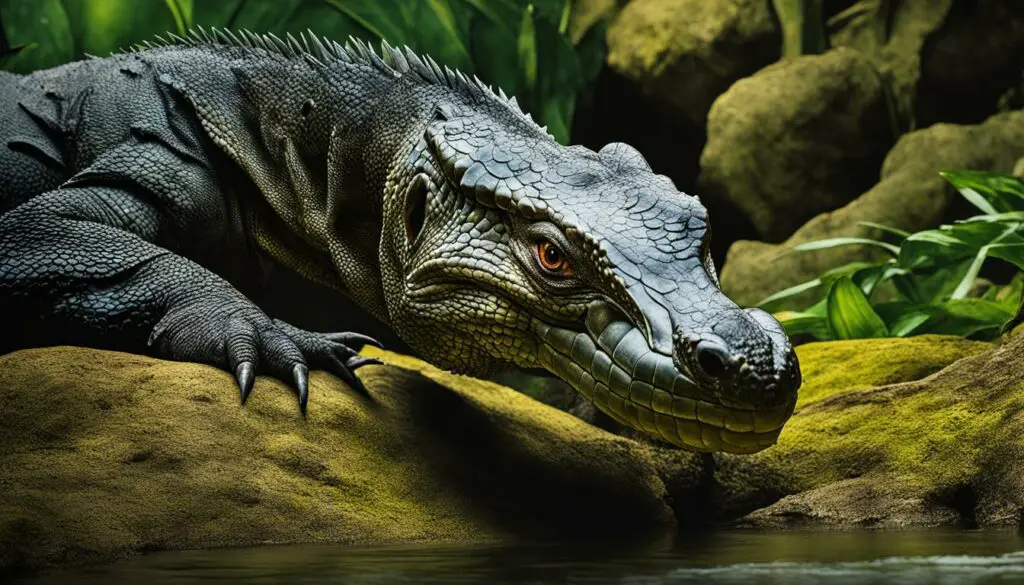
Table: Komodo Dragon Hunting Facts
| Fact | Detail |
|---|---|
| Average Prey Size | Deer, wild boar, water buffalo |
| Hunting Technique | Ambush predators, relying on speed and stealth |
| Senses | Long, forked tongue to detect prey direction |
| Weapons | Sharp, serrated teeth and toxic bacteria |
| Cannibalism | Known to cannibalize the young of their kind |
The hunting prowess of Komodo dragons is a testament to their incredible size and strength. As the largest lizards in the world, they have evolved to become fearsome predators, perfectly adapted to their environment. However, their conservation is crucial, as their numbers are dwindling due to various threats. Efforts must be made to protect these magnificent creatures and ensure their survival for future generations.
Komodo Dragons in their Natural Habitat
If you ever find yourself exploring the Lesser Sunda Islands in Indonesia, you may just have the chance to encounter one of the most fascinating creatures on Earth – the Komodo dragon. These awe-inspiring reptiles call this region their natural habitat, with the highest population found on the island of Komodo.
While their size and strength may command attention, it is important to note that Komodo dragons are a vulnerable species, according to the International Union for Conservation of Nature (IUCN). With an estimated population of around 6,000 in the wild, efforts are being made to protect and preserve these remarkable creatures. One such effort is the establishment of Komodo National Park, which aims to safeguard their habitat and contribute to their conservation.
Komodo Dragons in their Natural Habitat
The natural habitat of Komodo dragons is characterized by a diverse range of ecosystems, including tropical rainforests, savannas, and mangrove forests. These reptiles are well-adapted to their surroundings and can be found in both terrestrial and coastal areas. They are excellent swimmers and have been known to venture into the surrounding waters in search of food, making them formidable predators both on land and in water.
| Key Features of Komodo Dragon’s Habitat |
|---|
| Diverse ecosystems: tropical rainforests, savannas, and mangrove forests |
| Terrestrial and coastal habitats |
| Ability to swim and hunt in water |
However, despite their ability to adapt to different habitats, Komodo dragons have a limited range. This further emphasizes the importance of protecting their natural environment to ensure their continued survival. Climate change and habitat loss are significant threats to these magnificent creatures, as rising temperatures and increasing sea levels pose a risk to their habitats. Without effective conservation measures, the suitable habitat for Komodo dragons could decrease by 30% over the next 45 years.
As visitors, it is our responsibility to appreciate these creatures in their natural habitat while respecting the guidelines set forth by conservation organizations. By doing so, we can contribute to the preservation of Komodo dragons and their unique place in the world.
The Unique Reproduction of Komodo Dragons
Komodo dragons have a fascinating reproductive process that sets them apart from other reptiles. They possess the ability to reproduce both through mating and parthenogenesis. This means that females can lay fertile eggs without any contribution from males, although this method only results in identical offspring. In order to ensure genetic diversity and adaptation, it is crucial for the species to engage in mating.
Female Komodo dragons guard their eggs for several months until they hatch. The eggs are incubated in underground burrows to provide them with the optimal conditions for development. Once hatched, newborn Komodo dragons are already about 30 centimeters (1 foot) long, showcasing the remarkable growth potential of these creatures from birth. It takes them 5-7 years to reach their full size, during which time they undergo significant physical changes.
The unique reproductive process of Komodo dragons is a testament to their adaptability and survival strategies. While female Komodo dragons can produce offspring without mating, the introduction of genetic diversity through mating is crucial for the long-term viability of the species. It is a fascinating aspect of their biology that adds to the overall allure and complexity of these extraordinary creatures.
References:
- Source 1
- Source 2
The Venomous Bite of Komodo Dragons
Recent research has revealed that Komodo dragons have venom glands in their lower jaws, containing poison as potent as that of the deadliest terrestrial snakes. They deliver their venom by raking their teeth through the flesh of their prey, causing lowered blood pressure, impaired coagulation, and ultimately blood loss and shock. This adds to their predatory abilities beyond their size and strength.
“Komodo dragons possess venom glands that deliver a powerful toxin, which includes proteins that inhibit blood clotting. The combination of blood loss, tissue destruction, and toxic effects of the venom can cause rapid incapacitation of their prey.” – Dr. Bryan Fry, Venom Biologist
This venomous bite allows Komodo dragons to immobilize their prey, which can include animals larger than themselves. Once the prey is weakened, the Komodo dragon can begin its consumption, tearing the flesh apart with their sharp, serrated teeth. This unique adaptation sets them apart from other large predators and further emphasizes their status as apex predators in their natural habitat.
Rare Attacks on Humans
When it comes to encounters between humans and Komodo dragons, rare attacks have been reported, although data on their frequency is limited. While these powerful predators are capable of causing fatalities, such incidents are relatively uncommon. Most attacks occur in close proximity to the dragons and are more likely to happen during vulnerable activities such as urinating, defecating, or playing. It is important to exercise caution and respect the natural habitat of these fascinating creatures to minimize the risk of conflict. (Source: Third source)
Table:
| Year | Location | Activity | Outcome |
|---|---|---|---|
| 2013 | Komodo Island, Indonesia | Taking photographs | Severe bite injuries, hospitalized |
| 2016 | Rinca Island, Indonesia | Hiking | Minor bite wounds, treated on-site |
| 2019 | Komodo Island, Indonesia | Approaching too closely | No injuries, but charged by the dragon |
| 2021 | Flores Island, Indonesia | Picnicking near dragon habitat | No injuries, but chased away by the dragon |
While rare, attacks by Komodo dragons on humans do occur. It is essential to remember that we are visitors in their territory and must exercise caution and respect. The dragons’ natural behavior and instincts should be observed and admired from a safe distance, ensuring both human and dragon well-being. (Source: Third source)
Komodo Dragons in Peril
As the largest lizards in the world, Komodo dragons face an uncertain future due to the impacts of climate change and habitat loss. Rising global temperatures and the subsequent increase in sea levels pose a significant threat to their natural habitat. In the next 45 years, it is estimated that the suitable habitat for Komodo dragons will decrease by 30%. This alarming decline puts these remarkable creatures at risk of extinction, highlighting the urgent need for conservation efforts.
With an estimated population of only 6,000 individuals in the wild, the Komodo dragon is considered an endangered species. Efforts to protect and preserve their natural habitat are crucial in ensuring their survival. One such initiative is the establishment of Komodo National Park, a protected area aimed at safeguarding the dragons’ habitat and raising awareness about their conservation needs.
| Challenges faced by Komodo dragons | Conservation efforts |
|---|---|
| Climate change | Komodo National Park |
| Habitat loss | Awareness campaigns |
| Rising sea levels | Research and monitoring |
Protecting Komodo dragons is not only essential for the preservation of a unique and rare species but also for maintaining the balance of their ecosystem. As top predators, they play a crucial role in regulating the populations of their prey species. By conserving their habitat and raising awareness about their importance, we can ensure a future where these magnificent creatures continue to roam the earth.
Komodo Dragons in Peril
“The decline of the Komodo dragon population is a clear indication of the pressing need for conservation action. We must work together to address the challenges they face and protect these incredible creatures for future generations.” – Conservationist
- Climate change poses a significant threat to the Komodo dragon’s habitat.
- Habitat loss due to human activities further endangers their survival.
- Rising sea levels put coastal populations of Komodo dragons at risk.
It is crucial that we take immediate action to protect and preserve the Komodo dragon. Through collaborative efforts, research, and conservation initiatives, we can ensure a future where these majestic creatures continue to thrive.
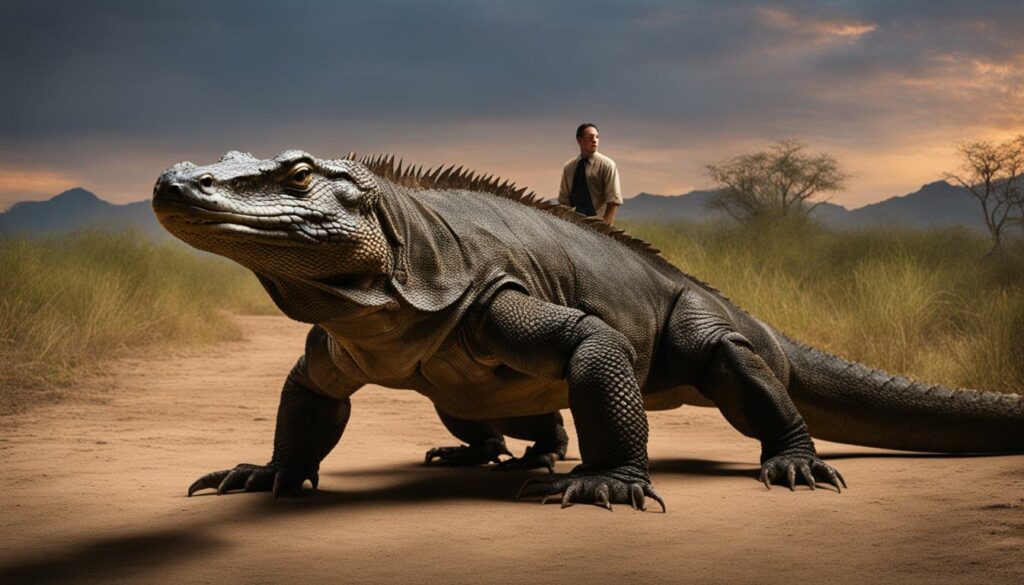
The Importance of Protecting Komodo Dragons
With their astonishing size and unique characteristics, Komodo dragons are a truly remarkable species. It is crucial to prioritize their conservation efforts to ensure the survival of these magnificent creatures.
Komodo National Park, established to protect these endangered reptiles, plays a vital role in their preservation. The park serves as a safe haven for Komodo dragons, providing them with a natural habitat where they can thrive.
Efforts to protect Komodo dragons extend beyond Indonesia. Zoos around the world also contribute to conservation initiatives, raising awareness about the need for their protection. These efforts aim to educate the public and inspire action to safeguard the future of this captivating species.
By protecting these fascinating creatures, we are not only preserving the Komodo dragon’s formidable presence on earth but also safeguarding the biodiversity of our planet. Each individual Komodo dragon has a unique role to play in maintaining the delicate balance of ecosystems, making their preservation of utmost importance.
Conclusion
The Komodo dragon’s size is truly astonishing. Adult male Komodo dragons can reach impressive lengths of up to 3 meters (10 feet), while females are slightly smaller, measuring around 1.8 meters (6 feet) in length. With an average weight of 70 kgs (154 lbs) and a maximum weight of 166 kgs (366 lbs), these creatures are the largest lizards in the world.
These formidable predators possess unique characteristics that set them apart. They have a muscular build, with a strong tail, powerful claws, and a large jaw filled with 60 large serrated teeth. Additionally, recent research has discovered that Komodo dragons have venom glands in their lower jaws, making their predatory abilities even more lethal.
Despite their large size, attacks on humans by Komodo dragons are relatively rare. However, their population is in peril due to climate change and habitat loss. Efforts are being made to protect and preserve this endangered species, with the establishment of protected areas such as Komodo National Park. It is crucial to raise awareness about the importance of conserving these fascinating creatures to ensure their survival for future generations.
How Does the Komodo Dragon’s Sense of Smell Contribute to Its Size?
The powerful sense of smell in komodo dragons is intertwined with their impressive size. With a keen olfactory ability, these iconic reptiles can detect carrion from miles away. As scavengers, their sensory prowess aids in locating food sources, allowing them to survive in their harsh environment and grow to become the largest living lizards on Earth.
FAQ
What is the average weight of a Komodo dragon?
The average weight of a Komodo dragon is 70 kgs (154 lbs), which is slightly heavier than the average weight of humans.
How heavy can a Komodo dragon get?
The largest recorded Komodo dragon weighed a whopping 166 kgs (366 lbs), surpassing the weight of a standard refrigerator.
How long can Komodo dragons grow?
Adult males can reach lengths of 3 meters (10 feet), while females are generally smaller, reaching a maximum length of 1.8 meters (6 feet).
How big are baby Komodo dragons when they hatch?
Baby Komodo dragons are already about 30 centimeters (1 foot) long when they hatch, and it takes them 5-7 years to reach their full size.
What is unique about the build of Komodo dragons?
Komodo dragons have a strong tail, powerful claws, and a large jaw filled with 60 large serrated teeth measured at 2.5 cm (1 in) in length. Their bodies are covered in osteoderms (bony plates) that provide protection, making them formidable predators.
What do Komodo dragons eat?
Komodo dragons prey on large mammals such as deer, wild boar, and even water buffalo. They are ambush predators, relying on their speed and stealth to catch their prey.
Where do Komodo dragons live?
Komodo dragons inhabit the Lesser Sunda Islands in Indonesia, with the largest population found on the island of Komodo. They live in a limited range and are considered a vulnerable species by the IUCN.
How do Komodo dragons reproduce?
Komodo dragons reproduce through both mating and parthenogenesis. Females can lay fertile eggs without any input from males, but this only produces identical young. For the species to continue to adapt, mating is necessary.
Do Komodo dragons have venom?
Recent research has revealed that Komodo dragons have venom glands in their lower jaws, containing poison as potent as that of the deadliest terrestrial snakes. They deliver their venom by raking their teeth through the flesh of their prey, causing lowered blood pressure, impaired coagulation, and ultimately blood loss and shock.
Do Komodo dragons attack humans?
While attacks on humans by Komodo dragons do occur, data on their frequency is limited. Most attacks happen in close proximity to the dragons, and they are more likely to occur during vulnerable activities such as urinating, defecating, or playing.
Are Komodo dragons endangered?
Due to the impacts of climate change and habitat loss, the Komodo dragon is considered an endangered species. Efforts are needed to protect and preserve this unique and rare species.
Why is it important to protect Komodo dragons?
With only an estimated 6,000 Komodo dragons left in the wild, their conservation is crucial. Ongoing efforts in Indonesia and in zoos around the world aim to protect these fascinating creatures and raise awareness about the need for their conservation.

